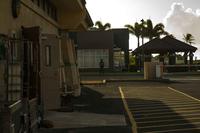The yearslong shortage of the Marine Corps' woodland top and bottom uniform items has finally relented, according to the manufacturer and distributors of the Marine pattern, or MARPAT, uniform that devil dogs rely on for their everyday wear.
Pandemic-related supply issues caused cammies to disappear from exchange store shelves over the last two-plus years, forcing Marines to wear other uniform options as they waited for stocks to replenish. Military.com reported in April that the Marine Corps was working to get these items back to exchanges, but some distributors such as the Navy Exchange, or NEX, still did not have stocks available.
Last week, representatives for the NEX and Marine Corps Exchange told Military.com that, despite some back orders, they were not experiencing delays for uniform tops and bottoms. Specifically, the NEX spokesperson said that its stores had 6,100 cammie units available on shelves, and that it expects the items to be available for purchase online by the end of the month.
Read Next: Trump Vows to Create Space National Guard as Issue Becomes a Political Lightning Rod Among States
"For a little over a year, the U.S. Marine Corps Combat Utility Uniform has been unavailable for purchase in store and online at myNavyExchange.com due to limited inventory availability," Courtney Williams, a spokesperson for the Navy Exchange Service Command, told Military.com via email Wednesday. "Most recently, however, NEXCOM was informed that the uniform's current stock level posture will now allow for inventory replenishment to resume."
Last week, the NEX website displayed a notice that the MARPAT uniforms were unavailable but, as of publication of this article, that warning does not appear on its site. A spokesperson for the Marine Corps' business and support services told Military.com that Marine Corps Exchanges were receiving "weekly" cammie deliveries from the Defense Logistics Agency, or DLA.
As the COVID-19 pandemic disrupted supply chains around the world, the manufacturer of the uniforms, American Apparel Inc., was also affected. Now, it appears that production is back on track at the manufacturing level, though some concerns remain.
"At the moment, it appears that we have caught inventories back up to the appropriate stock levels as requested," Chuck Lambert, the CEO of the company, told Military.com over email Thursday. "Shipments are on time, and order quantities of product have been consistent. We, along with two other prime vendors, were issued new contracts last year with better pricing to help us all with better wages for employees."
American Apparel has been producing the cammies since roughly 2001, Lambert said. At the time, and throughout the height of the Global War on Terror, "probably twice as many" uniforms were required then as today, he said. But the pandemic was where the true strain came from.
Lambert previously told Military.com that, as the pandemic ravaged manufacturing, his business lost critical workers and other companies that supported military products shuttered. He said he was able to increase wages during that time, but it was "costly, and we lost several million dollars but hung in there."
"It's still a challenge but things have improved," he added Thursday.
The disruption in supply caused critical shortages of the uniform over two years, resulting in Marines not being able to find their daily uniform and recruits not being issued a full set of woodland cammies. In April, a spokesperson for Marine Corps Installations Command told Military.com that recruits were back to a full set and that officials were prioritizing distribution at the recruit depots, Officer Candidates School and other major exchanges.
As a result of the shortage, however, the Marine Corps authorized commanders at the battalion level to allow Marines to wear different uniforms, specifically desert pattern uniforms or flame-resistant sets, also known as FROGs.
"What we cannot have is a situation where a Marine is wearing unserviceable cammies, because that looks bad for the Corps, and we can't have a situation where that Marine is being given a hard time about those unserviceable cammies," Gen. Eric Smith, the commandant of the Marine Corps, said last year of the policy.
The service acknowledged but did not respond by publication to questions about the abating of the shortage, or whether the alternate uniform policy has been or will be rescinded. The Defense Logistics Agency also did not respond by publication.
While stocks for woodland tops and bottoms have appeared to resume, there are still concerns among the manufacturers and distributors about other potential current or future shortages.
"We are currently tracking back orders for MCCUU 8-point cover and boonie cover in woodland and desert due to DLA contract issues that have delayed production," Bryan Driver, the spokesperson for the Corps' business and support services, said of headwear that Marines use. "Right now, we don't have a get-well date for these items."
Military.com asked for clarification on the contract issues, but was referred to the DLA, which did not respond.
Lambert said concerns with "fabric fiber increases" have made him wary of potential costs and "unforeseen issues and shortages due to companies just calling it quits and go[ing] home."
For him, the pandemic-related supply issues have brought further attention to the industrial base, and he urged others to pay attention to it. Currently, the Navy is struggling with supplying pants to its sailors, Military.com previously reported.
"We understand the need for high-end equipment to support any war or potential war effort. That's a given, but our troops should be able to get a uniform," Lambert said. "There needs to be a substantial increase for the soldiers' clothing items and not to buy more, but just help pay a little more to get the product available, so the producers can pay a competitive wage to keep people engaged in the industry.
"You usually get what you pay for or don't get it at all," he added.
Related: Marine Uniforms Will Hit Shelves Again After Nearly 2-Year Shortage, Corps Says












